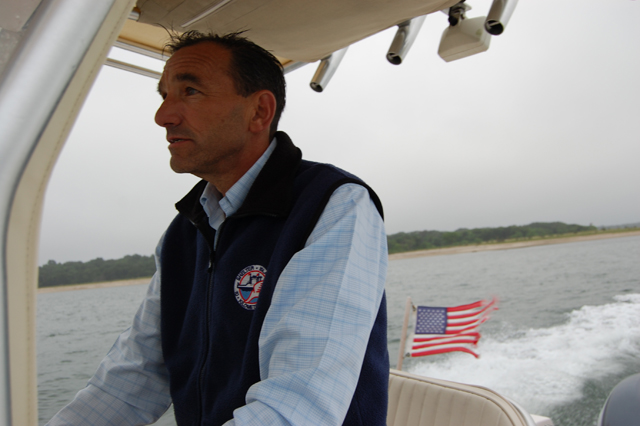Physician’s Profile: Commuting floats this ELIH doctor’s boat

For most of us, getting to work involves owning a car and operating it on roads shared with other vehicles. And just hearing the words “morning commute” can induce stress — which is not so good for your health.
Dr. Frank Adipietro commutes every day, but he measures his travel in nautical miles (11 each way) and his speed in knots (around 20). The internal combustion engine that gets him from his Shelter Island home to his job at Eastern Long Island Hospital in Greenport is an outboard 250HP Yamaha 4-stroke engine on a 23-foot Grady-White named MaryE — after his wife, Mary Ellen.
Dr. Adipietro is vice chairman of the board of trustees and president of the medical staff at ELIH, where he’s worked since 1998. He and his family live on Ram Island, a northeasterly arm of Shelter Island that extends into Gardiners Bay.
For 15 years, in rain, snow and fog, the man known to most people as Dr. Frank has commuted by boat. When he realized it could be done, he knew he had to do it.
“We live on an island and the hospital is on the water so it was a perfect setup,” he said. “If the hospital were half a mile inland, it wouldn’t work.”
When the weather is good, it typically takes him 20 to 30 minutes to get from the dock on Ram Island to his “personal parking space” — a slip he rents across the creek from the hospital.
Dr. Adipietro, an anesthesiologist, runs the hospital’s Interventional Pain Management Center, which serves patients from as far east as Montauk and as far west as Port Jefferson. On a typical day he might see 35 patients before heading back to Shelter Island in time to coach his son’s Little League team or attend his soccer games.
“When you are dealing with children’s schedules, you can’t be late,” he said.
In 1999, the first year ELIH offered pain management services, Dr. Adipietro saw about 50 cases. Within five years, the center was seeing about 3,000 cases annually. In 2013, 6,000 patients sought help for pain there.
“It’s a very, very busy program,” he said. “It just became a need that had to be filled. Everybody who works in the center knows we are dealing with a population of patients that are suffering, they are suffering a lot.
“It’s something we all know,” he continued, “to have the compassion and empathy to deal with someone in pain. Right now we are something of a destination service. We get referrals from a lot of different places. It’s worked out well for the patients and the hospital.”
His mornings on the water are often spent mentally preparing for the day ahead.
“I’m not one to listen to music,” he said. “I just look around and enjoy being on the water. You have to enjoy it. If you didn’t enjoy it, you wouldn’t do it. This is one of the great things about living on an island.”
Dr. Adipietro commutes by boat every day he can. Fog and rain are just excuses to drive a little slower. He once even crossed in a hailstorm that shredded the canvas T-top covering his cockpit.
“One thing that’s a problem in the winter is the cold … you can’t fire up a furnace on a boat,” he said.
A few years ago, Dr. Adipietro added heated gloves, a hat and a survival suit — which would theoretically give him 45 minutes to get out of cold water — to his arsenal of wintertime gear. He also hooks himself to a safety switch that cuts off the boat’s motor if he should fall overboard.
He never has fallen in while underway but he has slipped getting in and out of the boat at the dock.
“I have definitely been in the water … when that’s happened usually you are not thinking about safety, not, ‘This is dangerous ‘ — because it’s not,” he said. “You just get out of the water.”
And then there was the time he left for home in a December snowstorm so intense he lost his GPS and radar along the way. His half-hour commute expanded to 90 minutes and he was dependent on time-honored navigation techniques —primarily his knowledge of the water and local landmarks.
“In a storm you really have to go slow, but you have to keep going forward,” he said. “To have control of the boat, it has to be in motion.”
Dr. Adipietro remembers the time a man interviewing at ELIH for a nurse anesthetist position arrived at the Westhampton airport so late he couldn’t check in to his hotel. So Dr. Adipietro invited him to bunk with his family on Shelter Island.
It was February, he recalled.
“The good news is, you are coming to work with me,” Dr. Adipietro told the man. “The bad news is, you’re coming in a boat.”
And that’s how — on a sunny, 32-degree day with no wind — the two made the crossing together, the candidate wearing only a leather jacket and a really good attitude.
“He works here today, and he still tells that story,” Dr. Adipietro said. “The man has character, he has courage, there’s no question about it. He said, ‘It’s a little cold out here, but I’ll be fine.’ He jumped on the boat and said, ‘Let’s go.’ ”
This story originally appeared in the northforker 2014 Health & Fitness magazine








